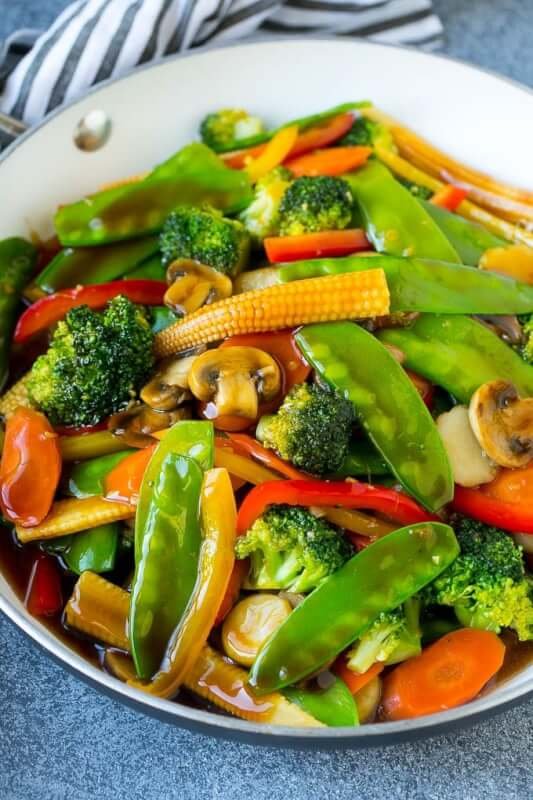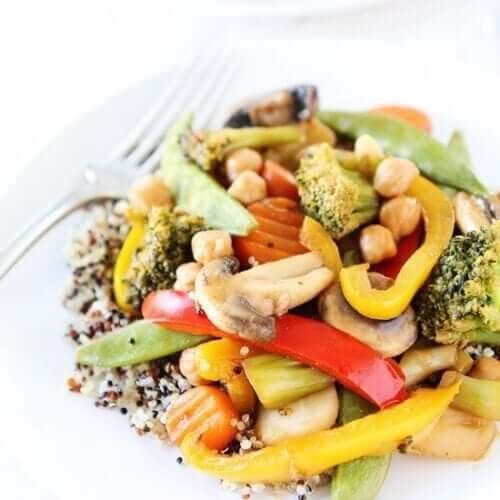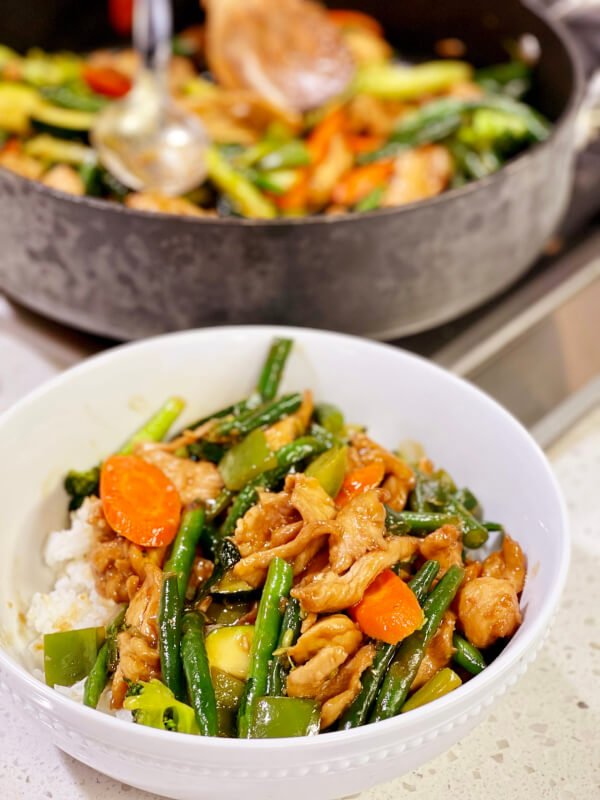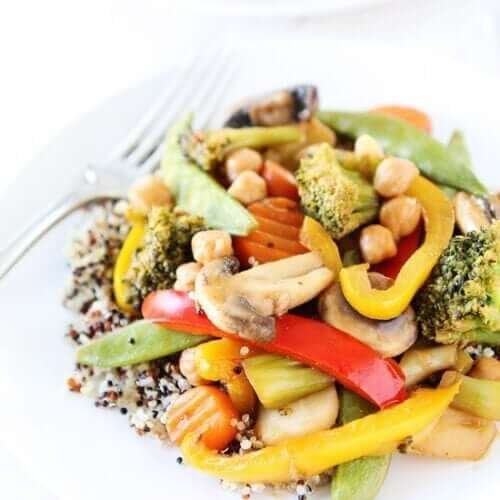In this article, you will discover a collection of delicious and nutritious garden stir-fry recipes that are not only quick to prepare but also promote a healthy lifestyle. With a colorful array of fresh vegetables straight from your garden, you can whip up these mouthwatering dishes in no time. Whether you’re a seasoned chef or a beginner in the kitchen, these recipes are sure to tantalize your taste buds and leave you feeling satisfied and nourished. So grab your apron and let’s explore the world of garden stir-fry together. Get ready to experience the perfect blend of flavors and textures right at your dining table.

Ingredients for Garden Stir-fry Recipes
Stir-frying is a quick and healthy cooking method that can transform a variety of fresh vegetables and protein options into a delicious and nutritious meal. To get started, let’s take a look at the key ingredients you’ll need for garden stir-fry recipes.
Vegetables
When it comes to garden stir-fries, the star of the dish is undoubtedly the vegetables. You can choose from a wide range of veggies, such as bell peppers, broccoli, carrots, snap peas, mushrooms, and zucchini. These vegetables not only add vibrant colors to your stir-fry but also provide essential vitamins, minerals, and fiber.
Remember to wash your vegetables thoroughly before cooking to remove any dirt or pesticides. Chopping the vegetables into bite-sized pieces will ensure that they cook evenly and are easy to eat.
Protein Options
To make your garden stir-fry a complete and satisfying meal, you’ll want to include some protein options. Tofu, chicken, shrimp, beef, and pork are all excellent choices. Tofu is a popular option for plant-based eaters, as it absorbs flavors well and provides a good source of protein. If you prefer meat, choose lean cuts and slice them thinly for quick cooking.
Seasonings and Sauces
To enhance the flavors of your garden stir-fry, you’ll need some seasonings and sauces. Common seasonings include garlic, ginger, and chili flakes to add a burst of flavor. You can also experiment with herbs like basil or cilantro for added freshness.
Sauces play a crucial role in bringing the stir-fry together. Soy sauce, oyster sauce, hoisin sauce, and sesame oil are all popular choices. These sauces add depth and complexity to the dish, so don’t be afraid to mix and match to find your perfect combination.

Preparing the Vegetables
Before you start cooking your garden stir-fry, it’s important to prep the vegetables properly to ensure they cook evenly and retain their vibrant colors and crunch.
Washing and Chopping
Begin by washing your vegetables under cold running water. Use a vegetable brush to remove any stubborn dirt or debris. Once clean, pat them dry with a clean kitchen towel or paper towels.
When it comes to chopping the vegetables, aim for uniform-sized pieces to ensure even cooking. Slice bell peppers and zucchini into strips, broccoli florets into bite-sized pieces, and snap peas and carrots into diagonal slices. By preparing your vegetables in advance, you’ll save time during the cooking process.
Pre-cooking Tips
Some vegetables may require pre-cooking before adding them to your stir-fry. For example, broccoli florets can benefit from a quick blanching in boiling water for about a minute to soften them slightly. You can also stir-fry tougher vegetables like carrots or green beans for a few minutes in a separate pan before combining them with the rest of the ingredients.
By pre-cooking certain vegetables, you ensure that all the vegetables in your stir-fry are cooked to perfection and have a well-balanced texture.

Cooking Techniques for Garden Stir-fry Recipes
Stir-frying is a versatile cooking technique that allows you to create a wide range of garden stir-fry recipes. Here, we’ll explore the basics of stir-frying and introduce some alternative cooking methods you can try.
Stir-frying Basics
To stir-fry, start by heating a wok or large skillet over high heat. Add a small amount of oil and swirl it around to coat the pan evenly. Once the oil is hot and shimmering, add your protein and cook until it’s almost done. Remove the protein from the pan and set it aside.
Next, add a bit more oil if needed and toss in your vegetables. Stir-fry them for a few minutes until they’re tender-crisp, retaining their vibrant colors. Add back the protein and any pre-cooked vegetables, along with your desired seasonings and sauces. Toss everything together until well-coated, and your garden stir-fry is ready to be served.
Other Cooking Methods
While stir-frying is the go-to method for garden stir-fries, there are other cooking methods you can explore to add variety to your recipes.
- Steaming: If you prefer your vegetables to be more tender and less crispy, steaming them briefly before stir-frying can achieve that texture.
- Grilling: Grilling some of the vegetables, like bell peppers or zucchini, before combining them with the rest of the stir-fry ingredients can add a smoky flavor and beautiful grill marks.
- Roasting: For a different twist, toss your vegetables with some oil and roast them in the oven before mixing them into your stir-fry. Roasting can bring out the natural sweetness of the vegetables and add depth to the dish.
Don’t be afraid to experiment with different cooking methods to find your favorite way of preparing a garden stir-fry.

Garden Stir-fry Recipe Ideas
Now that you know the basics of stir-frying and how to prepare the vegetables, let’s explore some delicious recipe ideas to inspire your next garden stir-fry creation.
Garden Vegetable Stir-fry
This classic garden vegetable stir-fry celebrates the vibrant colors and flavors of a variety of fresh vegetables. Start by stir-frying bell peppers, broccoli, snap peas, and carrots until they’re tender-crisp. Add minced garlic and ginger, along with your favorite sauces like soy sauce and sesame oil. Toss everything together, and you have a colorful and nutritious garden vegetable stir-fry.
Spicy Tofu and Vegetable Stir-fry
For those who enjoy a bit of heat, this spicy tofu and vegetable stir-fry is a perfect choice. Stir-fry tofu until it’s golden and crispy, then set it aside. In the same pan, stir-fry bell peppers, mushrooms, and zucchini until tender. Add in minced garlic and chili flakes for a spicy kick. Finally, combine the tofu with the vegetables and drizzle with a spicy sauce made from soy sauce, hoisin sauce, and sriracha. This stir-fry is sure to satisfy your cravings for both spice and protein.
Garlic Shrimp and Broccoli Stir-fry
Seafood lovers will delight in this garlic shrimp and broccoli stir-fry. Begin by stir-frying the shrimp until pink and cooked through, then remove from the pan. In the same pan, stir-fry broccoli florets and sliced carrots until tender, adding minced garlic for flavor. Mix the shrimp back in, along with a savory sauce made from soy sauce, oyster sauce, and a touch of honey. The combination of juicy shrimp, crisp broccoli, and the aromatic garlic will make this stir-fry a family favorite.

Tips for Making Quick and Healthy Garden Stir-fry Recipes
To ensure your garden stir-fry recipes turn out quick, healthy, and delicious, here are some tips to keep in mind.
Plan Ahead and Prep Ingredients
Before you start cooking, take a few moments to plan your stir-fry. Think about the vegetables and protein options you want to use, as well as the seasonings and sauces. Prepping all the ingredients in advance will save time during the cooking process and help you stay organized.
Cook in Batches
If you’re making a large batch of garden stir-fry, it’s important to cook the ingredients in batches rather than overcrowding the pan. Overcrowding can lead to uneven cooking and soggy stir-fry. By cooking in smaller batches, each ingredient will have ample space to absorb heat evenly and develop those desirable charred edges.
Use High Heat
Stir-frying is all about high heat. When you’re ready to cook, make sure your wok or skillet is preheated properly before adding the oil and ingredients. The high heat will help to quickly sear the protein and vegetables, preserving their colors and textures.
Add Sauce at the Right Time
To prevent your stir-fry from becoming too saucy or watery, add the sauce towards the end of the cooking process. This allows the sauce to thicken slightly and coat the ingredients evenly, rather than getting diluted by excess liquid.
By following these tips, you can create irresistibly flavorful and healthy garden stir-fry recipes in no time. Enjoy the fresh and vibrant flavors of your favorite vegetables while maintaining a nutritious and satisfying meal. Happy stir-frying!


